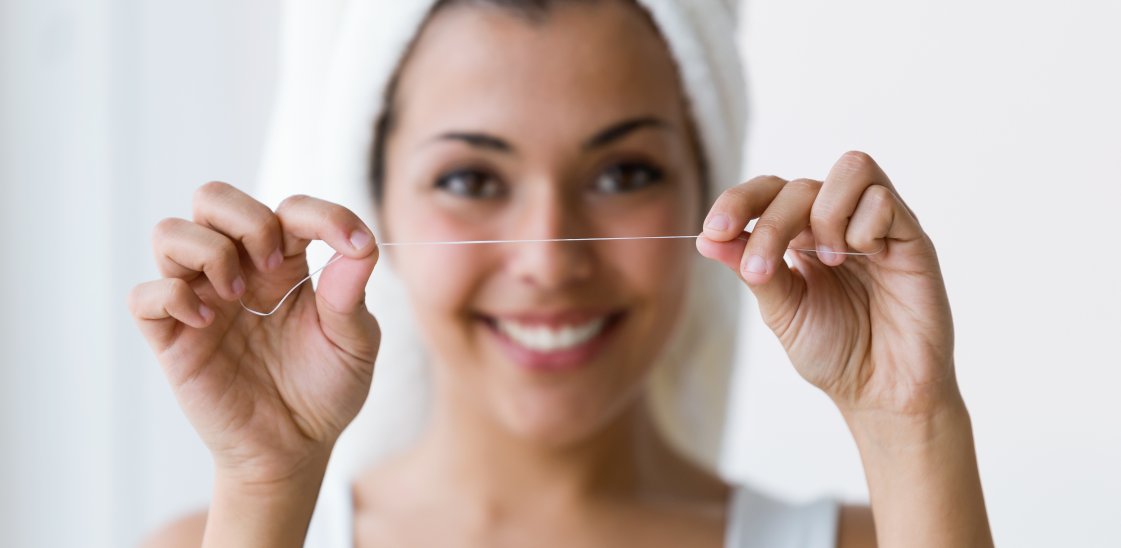
How Do You Floss Properly?
Flossing is a really important part of your oral hygiene routine. It can help dislodge food particles that have become stuck between your teeth during the day and reduce the amount of plaque and bacteria that builds up on your teeth and gums.
When plaque isn’t removed and is left on the surface of your teeth, it can contribute to further issues, such as cavities and gum disease. Brushing alone only cleans around 60% of your teeth, and therefore, both flossing and brushing together keeps your teeth clean and your mouth free from further health issues.[1]
According to a recent YouGov study, only 31% of people in the UK floss daily. However, even for those who do floss daily, the process can be ineffective and potentially harmful for your teeth and gums if practised improperly. If you are unsure how to floss properly, or if you have simply never been shown, here’s a basic step-by-step guide on everything you need to know about flossing.[2]
How to use dental floss
When it comes to effectively removing plaque and dislodging food from your teeth, you need to be sure you’re using the correct flossing technique. Before starting to floss, you should always wash your hands thoroughly as you will be putting your fingers in your mouth as you floss. When using loose dental floss, rather than a flosser, proper flossing technique can be achieved in four easy-to-follow steps.
Step 1: Break off a piece of floss
Remove and break off around 18 inches of dental floss (roughly 45cm) and wind the ends loosely around one finger of each hand. Hold it tightly between your thumbs and forefingers, creating a taut suspended band of around one to two inches.
Step 2: Floss between each tooth
Using your thumb and index finger to guide the floss, place the taut band in between two teeth and gently slide the floss in an up-and-down motion (not a side-to-side motion), ensuring you rub it against both sides of each tooth. Be careful not to slide the floss into your gums as this can cause scratching which can make your gums bleed.
Step 3: Clean between your teeth and gums
When you do reach the gum line in between each tooth, curve the floss at the base of the tooth and create a ‘C’ shape with the floss. This helps to clean the spaces between your teeth and gums and also allows the floss to better remove plaque from behind your teeth. Do this as gently as possible to ensure you do not damage the tooth or gum line, or snap the floss as you go.
Step 4: Repeat for each tooth
Repeat this process, moving from tooth to tooth. Each time you move to a new tooth, use a fresh and clean section of floss by slowly unwinding the length from one of your fingers.
This basic flossing technique can be practised using any type of floss, from the simple waxed variety and spongy flosses to dental tape. Additionally, it doesn’t matter if you choose to start with your upper or lower teeth or whether you move front to back, as long as each tooth is properly flossed by the time you are finished.
When using loose dental floss, this simple and safe technique will help you to remove any food particles and plaque that may have built up between your teeth and gums – and it can ultimately improve your overall oral health.
How to use floss picks
Some people may find regular floss awkward and even uncomfortable to use. This can be especially noticeable when trying to reach back teeth with floss simply suspended between two fingers. However, this shouldn’t put you off interdental cleaning. Removing food particles and plaque from between your teeth and along your gum line is an important aspect of oral hygiene, so, if you are struggling to use standard floss effectively, it’s important to remember that there are alternatives to traditional floss available that may work better for you.
An alternative to traditional dental floss, hand-held floss picks can be utilised using a similar technique to the above. Floss picks feature an angled and curved head that holds a short band of floss in one place. They are also ideal for carrying when on the go!
Step 1: Take your floss pick
These dental tools can be used more than once, so take the pick that you currently have on the go or select a brand new one from the pack.
Step 2: Hold the handle and floss between each tooth
Unlike dental floss, which requires two hands to use, floss picks only require one hand. Simply hold the flosser firmly between your finger and thumb and angle the tool’s head to the area that you want to floss.
Step 3: Bend the floss to get in between the tooth and gum
Guide the floss gently between two teeth and use the same back-and-forth motion needed when using standard floss. Don’t forget to move up and down the sides of the teeth as well!
You may find that bending the strip of floss around each tooth to clean along the gumline and behind your teeth is much easier with a flosser, as manoeuvring and controlling the floss with the help of a handle can make the action feel more natural.
DenTek’s Triple Clean Floss Picks, like the rest of the floss pick range, have an inbuilt textured toothpick at one end of the handle which can be used to remove any larger food particles stuck between your teeth, and can be used to stimulate the gum too.
How to use an interdental brush
Another common alternative to traditional dental floss is interdental brushes. These tools typically have small bristled heads, are tapered at one end and resemble small pipe cleaners with handles. They are designed to fit in even the tightest gap between teeth to help dislodge food and remove plaque buildup from the gum line and teeth. Interdental brushes are a great alternative for those who find dental floss awkward to use.[3]
To use an interdental brush, first you need to choose from a variety of different sizes and designs and select a brush that suits your specific needs. Your dentist will be able to help you with this if you are struggling to choose the right one – or we recommend our Easy Brush Mixed Starter Pack to trial what size is best for you.
Once you have the right size for you, simply insert the brush gently between your teeth, one by one, and move the brush back and forth carefully. You can choose to change the size and curve of the neck to clean those difficult-to-reach areas at the back of your mouth and use a bigger brush head for larger gaps. As the filaments become worn (the fine individual brush hairs located on the pick), you should change your brush. As a rule of thumb, this will be after approximately three uses.
How to floss with braces
If you currently have braces or other similar dental appliances, using the correct flossing technique is particularly important in order to avoid floss getting caught in any wires or brackets, or actually damaging your dental appliances.
The best way to floss to prevent damaging your braces is to use special orthodontic floss which typically has a stiff end that can be simply threaded under the main arch wire of your braces. Alternatively, you can purchase a ‘floss threader’ – a small device that allows you to place regular floss under the main wire of your braces and floss as normal, using the technique outlined above.
An interdental brush can be used to remove any food from the braces themselves, by pushing it up between each metal slat. If you’re unsure about how to floss with braces, you can ask your dentist or orthodontist for advice.
Should you floss before or after brushing?
You should always floss before brushing your teeth. This is because flossing can dislodge the small particles of food from between your teeth, and brushing them sweeps them away and removes them altogether.[2]
How often should I floss?
You should floss once a day. This means that you could choose to floss in the morning and then brush your teeth both morning and evening, or vice versa. It may be more beneficial to floss in the evening to remove any food particles that have become stuck during the day, and you can go to bed knowing you have a completely clean mouth.[2]
Resources:
[1] https://www.nhs.uk/live-well/healthy-teeth-and-gums/how-to-keep-your-teeth-clean/
[2] https://www.nhs.uk/common-health-questions/dental-health/why-should-i-use-dental-floss/
[3] https://www.nhs.uk/common-health-questions/dental-health/why-should-i-use-interdental-brushes/




